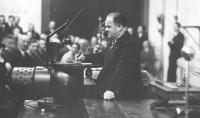The Year of Wolfke, Part 3. Crystals are small diffraction grids

Professor Mieczysław Wolfke delivering his lecture entitled "New elementary particles" - standing next to an experimental apparatus, photo: National Digital Archives collection
There are works that change people's fate, and even the fate of the world. This might have been the case with Mieczysław Wolfke's publication entitled ‘Über die Möglichkeit der optischen Abbildung von Molekulargittern’ (On the possibility of optical imaging of molecular grids). However, this never really happened. We would like to invite you to the next part of the story about a unique researcher and inventor associated with the Warsaw University of Technology.
The year 2022 is dedicated to Wolfke. In this way, the Polish Physical Society, Warsaw University of Technology, the Physics Committee of the Polish Academy of Sciences and the Polish Photonic Association commemorate a unique researcher and his achievements.
Interested in research
In the work that did not eventually bring Wolfke recognition, he put forward an idea that might have come to his mind during his stay in Karlsruhe. Today we would say that Wolfke was on a post-doctoral internship there in 1912 in the team of Prof. Otto Lehmann, nowadays called the father of liquid crystals. It was the time when Max von Laue (later reviewer of Wolf's work in the habilitation study in Zurich) and William Henry Bragg and his son created a new research method of the structure of matter, consisting in treating crystal lattice atoms as diffraction grids for X-rays. This discovery was honoured with Nobel Prizes in 1914-1915.
- ‘Wolfke, whose doctorate concerned the theory of optical imaging of diffraction grids, of course had to know these results and be keenly interested in them – says Krzysztof Petelczyc, PhD Eng. from the Faculty of Physics of the Warsaw University of Technology, the co-author of the researcher’s biography, and the coordinator of the celebrations of the Year of Mieczysław Wolfke.’ – ‘Especially since Wolfke had been fascinated by news from the world of science since his childhood and had been following the reports published in the leading scientific journals.’
Halfway through the imaging process
In his research on light, he dealt with the physics of image formation. He could very well be called an expert in this field.
– 'Reading about X-ray diffractometry, as that is the name of the method, he quickly realized that X-ray-blackened film, containing an interference pattern indicating the distance between atoms, is nothing more than a primary image of a molecular network,' explains Krzysztof Petelczyc, PhD Eng. – ‘A primary image like this is like halfway through the imaging process.’
As it is known, imaging is a technique aimed at creating a light distribution on the screen that will render a certain object (glowing or illuminated) as accurately as possible. It turns out that the physics of this process can be divided into two stages.
– ‘In the first one, a primary image is created, the so-called spatial spectrum of the optical field, in which the information is divided into areas corresponding to minor details, i.e. rapid changes in contrast and areas of more uniform brightness’ – explains Krzysztof Petelczyc, PhD Eng. – ‘Running on, the light again creates an image which is geometrically similar to the object.’
The main idea of holography
Wolfke noted that if the primary image of a molecular network is saved, it can be treated as an object (diffraction grid) that will reproduce the image of atoms in the first stage of imaging. The statement formulated by the researcher in the words "the primary image of the original image is similar to the object" is indeed the main idea of holography.
– ‘I believe that for Wolfke this statement was, on the one hand, quite natural, because this is basically how the process of creating images is described, but, on the other hand, the idea of saving the original image was something completely new’ – notes Krzysztof Petelczyc, PhD Eng. – ‘As it turned out later, in this way it is possible to keep information about the phase, i.e. the direction of the light course, and not only its brightness. Wolfke proved analytically his equation under certain conditions, and also suggested using visible light instead of X-rays to recreate it. As he concluded, this would allow for a very large magnification of the image of the molecular network, enabling the atoms to be seen using a microscope.’
Nobel Prize not for Wolfke
The developed theory could not be confirmed experimentally. Perhaps that is why the work was published only in 1920, when Wolfke, in anticipation of moving to Poland, closed the research projects carried out in Zurich.
– ‘Wolfke clearly wrote at the end of the article that he had tried experiments but lacked strong sources of coherent light,' says Krzysztof Petelczyc, PhD Eng. – ‘Lasers that meet these requirements were invented only in the 1960s, and the concept itself, although published in one of the most renowned scientific journals of that time – "Physikalische Zeitschrift" – has been forgotten.’
In 1947, in the year of Wolfke's death, two-stage imaging was independently rediscovered and patented by Dennis Gabor. His successful experiments in the 1960s proved the correctness of the theory and brought him the Nobel Prize in 1971. When he received it, Gabor said that he had used the works of Frits Zernicke and the Braggs, not knowing that Wolfke had actually proposed the same method as early as 1920.







